Entries Tagged 'freelance copywriter' ↓
April 12th, 2010 — copywriter, email copywriting, email marketing, freelance copywriter

Keeping in touch with new, prospective and existing customers has always been a headache. How much contact is too much? Should you contact them after they have purchased? Will it seem pushy if you continue to ‘pester’ them?
However, marketing to your existing customer base remains one of the most effective ways to promote your products and services.
After all, if they’ve bought from you once, they probably will again.
Be careful what you say
Although many more businesses today are turning to email marketing as a quick, effective, and relatively inexpensive method of promoting their products, they make one fatal mistake.
When an email campaign fails to deliver the expected return, it’s all too easy to blame:
- the copy of the email
- the subject line of the email
- the day it was sent out on
- the time it was sent
- the offer it contained.
Yes, some of these could have an effect if you don’t get them right, but there is a fundamental aspect of email marketing that is more likely to blame.
It is an error that is seen time and time again. What’s more, it occurs because the business doesn’t have the right tools for the job.
If you look at your mailing list, not everyone is going to be interested in the same information. For example if you run a pet supplies company, some of your customers will be interested in supplies for their cats, some for their dogs and some for their horses.
So if you have an offer on dog collars and you send that out to everyone on your list, it will only appeal to about a third of those people contacted.
If people on your list are constantly being sent information they don’t want or need, there is a good chance that your email will either be deleted (best case scenario) or they’ll unsubscribe.
Email marketing is great if you send the right information to the right people.
Divide and conquer
The key is to devise campaigns that are only sent to the customers who are likely to be interested in them. Now, not all software will allow you to do this and some of you will have vast mailing lists which makes it an impossible task to do manually. But, if you can do it, it will make a world of difference to your response rate.
So, your dog collar promotion will only go out to your dog owners. By tailoring your marketing to the direct needs of your customers, you are maximising your opportunities of making a sale. This will also have the effect of ensuring the information you send is relevant, of interest and therefore will enhance your relationship with them.
If you ignore this and simply bang out emails again and again to your entire list, you’ll start to alienate yourself. No one wants their inbox filled with ‘rubbish’.
A monthly general newsletter to your entire list will keep regular contact with everyone (just try to make sure there is something for everyone in it). This is great to keep the name of your business in their mind so when they are ready to make a purchase they will (hopefully) come to you. But special offers must be segmented.
Why do you need to know this?
Email marketing is a very efficient way of promotion and selling, but the blanket approach will do more harm than good.
If you consistently send information to people who don’t want it, they’ll unsubscribe. It will come across as though your organisation is remote and out of touch. Taking the effort to tailor your message to your recipients will enhance your chances of a sale and strengthen your relationship with them. You will come across as someone who cares, someone who doesn’t send them useless information and only sends things that you know are relevant to them.
So if your email campaign doesn’t perform as you expect, don’t immediately blame the copy, subject line or offer; take a look at who you sent it to. That could be where the problem lies.
April 9th, 2010 — copywriter, freelance copywriter

Every so often we all need a bit of help – especially with the stuff we find mundane.
At times its easier to get someone else in so our time can be freed up to do something more productive.
That is especially true for sales writing.
Many businesses simply don’t have the time to sit down and create amazing copy that will wow their readers and have them opening their wallets. So the most sensible option is to hire a freelance copywriter.
Your copywriter is probably sourced through Google or by recommendation. But however you find them, its what you do next that’s important.
We are creative but not miracle workers
Being a writer means being creative, but even copywriters have their limitations.
Our job is to produce copy for your marketing materials (web copy, brochures, emails, newsletters, white papers, eBooks, travel guides…) that sells. It has to be eye-catching, captivating, powerful and interesting.
If it is for search engine optimisation, it also has to appeal to the search engine spiders.
The one thing we can’t do is magic powerful copy out of thin air.
Don’t make your briefs too brief
To be able to write great copy, your copywriter will need a great brief – and that means information. Even though you’ve hired them to write, you still have to do some work.
To say “I import handbags and I need you to write my web copy.” isn’t really enough. What are the bags? What styles do they come in? Are they designer? What are they made of? What makes them different to other handbags?
Your copywriter needs as much background information as possible on your product to be able to put together your copy. You’ll need to be able to answer questions such as:
- What is the objective of this project?
- Who is the audience?
- Do you have any in-house styles they must adhere to?
- What is the product/service? (Features, benefits, prices etc.)
- What is the offer? (Discounts, deadlines, guarantees etc.)
- What are the objections stopping people buying your product?
- What is the call to action? (What do you want the reader to do? Call, email, order etc.)
- What media is the copy for? If web copy what keywords should be used?
- What information is available about this product?
- Who are your main competitors?
Give them everything you can think of. Write down your ideas – don’t worry about presentation and grammar, just let it flow as all information is useful when it comes to constructing strong sales copy.
Not giving them this information is rather like asking someone to build your dream house without any plans, ideas of location or style – you simply won’t get what you want.
Don’t leave it to the last minute
Most companies will have their marketing strategies planned out in advance, so don’t leave it until the eleventh hour to find and commission your copywriter.
Gathering information takes time, crafting it into strong sales copy takes time, proofreading and editing takes time.
Remember your copywriter also has a life. Why should they be forced to work late into the evenings or weekends to get your project finished because you didn’t leave enough time.
Why am I telling you this?
Simply because there have been occasions when I’ve been expected to conjure great copy out of thin air.
Because I’ve been asked to produce copy within only a few hours.
Because people have moaned when I’ve asked for information – “but you’re a writer!”
Because if you know how copywriters like to work, projects will run much smoother.
If you want great quality copywriting give information, give plenty of time and give generously!
April 7th, 2010 — copywriter, copywriting tips, freelance copywriter

A big part of producing copy that sells is understanding what your reader wants to hear.
The problem is everyone is different. We all have different dreams, wants and goals, so how can you produce a piece of sales writing that is going to appeal to everyone?
You can’t please all of the people all of the time
You really can’t.
If you try to perform this particular miracle your writing will become confused and unfocused.
My elder son recently returned from a school French exchange trip. Before he left, he was busy practicing a few phrases. His great plan (and that of most of his class mates) was to come up with a conversation that would take place once they met their French families. It went something like this:
Robert: Bonjour
French family: Bonjour, avez-vous fait bon voyage?
Robert: Oui mercie. Êtes-vous bien?
French family: Oui, et vous?
Robert: Très bien, merci, mais je suis un peu fatigué
(Please excuse my French, it’s been a number of years since I studied the language.)
In his mind this was perfect; it would work like a dream and get his exchange trip off to a flying start.
Sadly, I did have to point out that, although it was a great idea to be thinking along the lines of what he was going to say to the family, as being as no one has told them of this cunning plan, the likelihood of the conversation panning out like that was remote.
As predicted, after practicing said conversation with his friends prior to arriving in Arras, once they got off the coach and met their families, one of two things happened: they either totally forgot what they were going to say, or the family threw in a curved ball and asked them something they hadn’t practiced.
The one way conversation
As a copywriter, I find the most effective way to write is conversationally. But that doesn’t mean like the example above. I don’t have a two way conversation going on in my head as I write.
It is rather the style that is conversational. In other words the language that I use is informal, my vocabulary is simple to understand and my sentence construction simple to follow.
Using this style helps build rapport with the reader; it makes the information I am giving them accessible. If you think about it, what would you rather read? Something that is easy to grasp or something that you have to go over several times to understand the gist of what’s being said?
Of course, there are some occasions when a slightly more formal approach is called for, but again by using language that is accessible to all, you are increasing the chances of your copy having the desired affect.
So if you want your copy to hit the spot every time, remember:
- Write to your audience
- Talk to them – use ‘you’ and ‘your’
- Keep your language simple
- Don’t use jargon
- Make sure your sentence construction is easy to follow
- Don’t make assumptions
- Keep it conversational
- Use story telling techniques
- Ask questions
Why do you need to know this?
If your sales copy is going to sell, it has to make a connection with your reader.
Over my career as a freelance copywriter, I have written for numerous industries and audiences. The one common factor in all of my writing is keeping it simple.
A frequent conversation I have with clients involves this exact feature. Often they believe that a copywriter is there to make them sound very grand and impressive.
Wrong.
Your copywriter is there to sell your products and services. And the best way to do that is by keeping the copy simple, strong and striking.
April 5th, 2010 — copywriter, freelance copywriter, SEO copywriter, seo website copywriter

There you go, probably the shortest blog post in the history of blogging.
But, I guess you’re going to want more than just a resounding YES; you’re going to want evidence.
If you’re sitting comfortably, I’ll begin
There have been various debates about whether SEO copywriting is really so different to your normal, run of the mill website copy. Some people say there is no difference, whereas others say there is a vast difference between the two.
From my point of view, yes, search engine optimisation copywriting is very different from normal website copy.
For a start you are writing for two audiences simultaneously – your reader and the search engines. But the trick is to write your copy in such a way that your reader doesn’t pick up on your SEO.
Case Study: Landspeed
I was recently asked to write SEO copy for Landspeed’s new website. Landspeed is a car MOT and servicing centre based in Ipswich. They wanted copy that was easy to read, interesting and written to help their on screen SEO.
The copy had to target various keywords such as Ipswich MOT, Car servicing Ipswich, MOT Ipswich, Ipswich car servicing.
Less than a week after the site going live, it was on the first page of Google for all these terms (as at 1/4/10) – want proof?
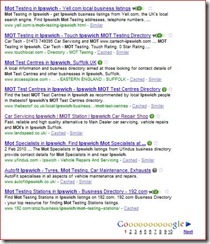
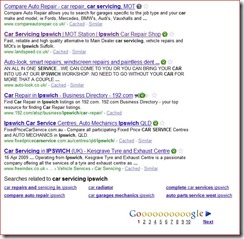
Ipswich MOT Car Servicing Ipswich
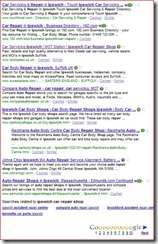
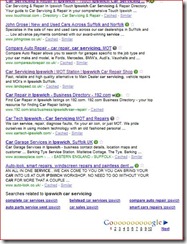
Ipswich Car Repair Shop MOT Ipswich
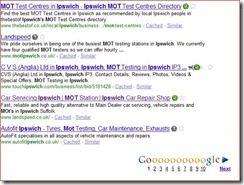
Ipswich Car Servicing
And, that was achieved without doing any link building.
Take a look at the site…
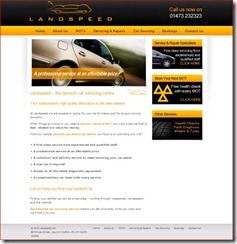
…unlike the sample I showed you in my last blog post about how not to do SEO, the copy isn’t crammed full of keywords. It is readable, simple copy that tells the reader exactly what the company does. The keywords have been used where they are most effective – headings, sub headings and as internal hypertext links.
When writing SEO web copy another key aspect that your copywriter should know about, is the value of the title tags (or page titles). Getting your keywords in here (but in a natural way, not stuffed) will help your rankings no end.
Now I’m not saying that every website I’ve ever written ends up on the front page of Google within days. SEO can take time. It all depends on how competitive the terms are that you’re trying to rank for. Something as generic as freelance copywriter will take longer than a more localised term such as Suffolk freelance copywriter.
That’s not the end
But even when you do achieve front page rankings through your copywriting, it doesn’t stop there. You have to consolidate that position by building quality, inbound links to your site through:
- article marketing
- blogging
- inclusion to relevant directories
There’s a lot of competition out there. When you reach the top of the Google pile, someone will be waiting to knock you off. SEO is a constant process and one you can’t take your eye off for a second.
March 31st, 2010 — copywriter, freelance copywriter, search engine optimisation, SEO copywriter
I’ve often talked about the importance of search engine optimisation when creating website copy.
Keyword stuffing is a frequent practice that was done to try and attract the search engine spiders. Web site owners researched their keywords and simply used them as many times as possible within their text.
The hope was that the search spiders would jump for joy because of the number of keywords. And the site would then appear in the top listings because it was deemed highly relevant.
That might have been the hope but the reality was somewhat different. Although sites like these may well have achieved good rankings, their conversion rates were lower than half the teenagers trousers are these days.
The problem is that stuffing your copy with keywords renders it unreadable to people. If they can’t read it or it doesn’t make sense, they’re not going to hang around.
A classic example of this was recently highlighted in one of Nikki Pilkington’s tweets:
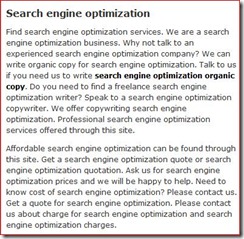
This has come from an actual site – a copywriting site! This single snippet contains the phrase ‘search engine optimisation’ no less than 17 times!!!!
Eek! Now do you see what I mean by unreadable?
This is an extreme example and I find it unbelievable that any copywriter would think that this sample of their ‘writing talent’ would convince a client to buy their services.
SEO done correctly will look like normal text. The keywords may not even be obvious because they appear naturally within the copy. After all if you sell orange dog collars, the likelihood is that that phrase is going to pop into your copy anyway.
The position of your keywords is far more important than their frequency.
SEO is a game
The game of SEO is about playing by Google’s rules to achieve good rankings. It’s about patience and research – things won’t happen over night. And above all it’s about understanding what your customer wants.
Unlike other marketing methods that are pushed in front of the reader (such as adverts, newsletters etc.), you can’t push your website in front of someone. Instead you have to make it attractive enough for them to find it.
Therefore you have to understand them and work out what they are searching for. Then, and only then, can you optimise your site and continue tweaking until you get great rankings.
Why do you need to know this?
Don’t get ripped off. If you approach a freelance copywriter to help you with your on page SEO, check out their website:
- Do they rank for their keywords? (if you found them through a Google search and are in the organic listings rather than sponsored links, the answer is yes)
- Is their site readable?
- Do they understand SEO?
- Do they ask you for your keywords?
If you answer no to any of the above they probably aren’t right for you.
If they start harping on about keyword density and their site looks like the one above, run away as fast as you can.
SEO copywriting is an art as much as it is a science – make sure you hire someone who is a Jedi Master in both.
















